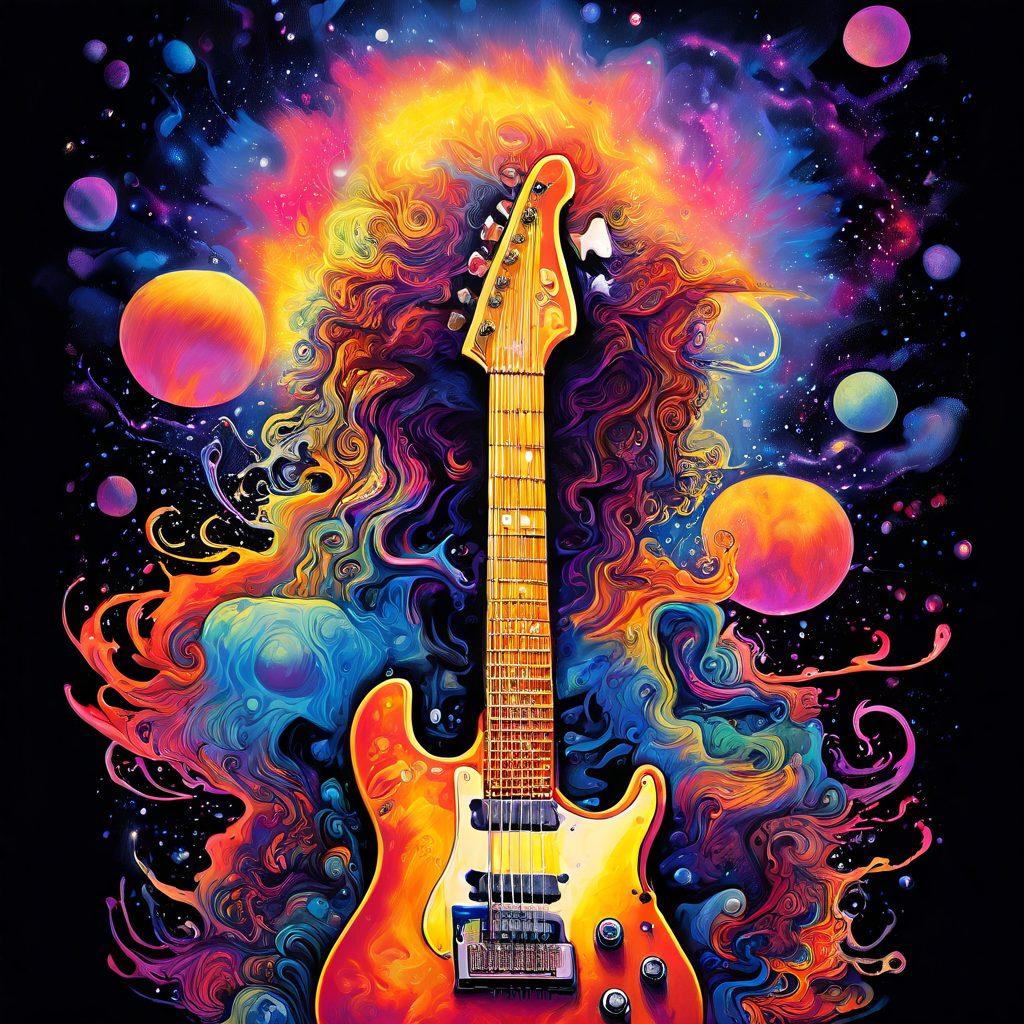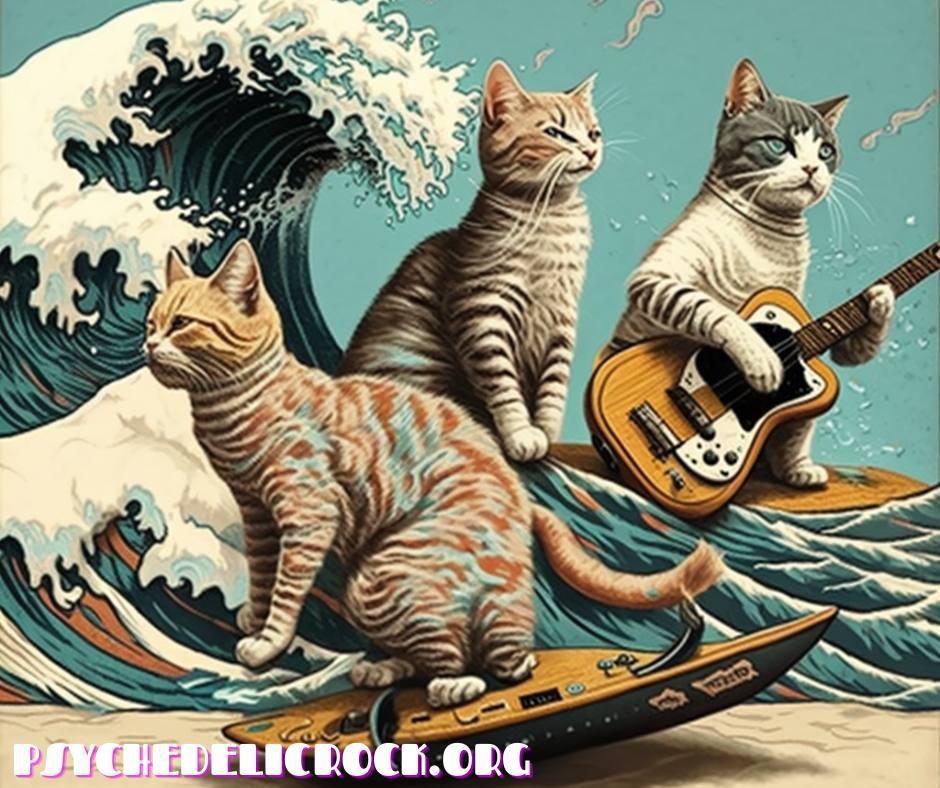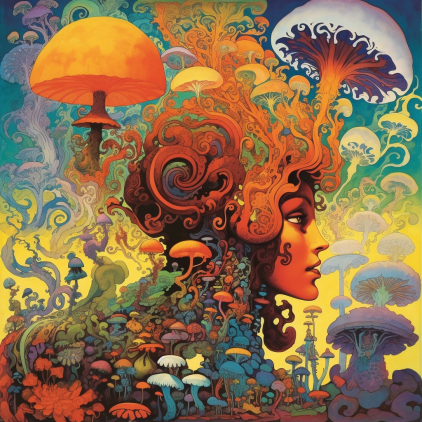
 Psychedelic Rock Subgenres – A Comprehensive Guide to Acid Rock, Space Rock, and Neo-Psychedelia
Psychedelic Rock Subgenres – A Comprehensive Guide to Acid Rock, Space Rock, and Neo-Psychedelia
Leave a comment
Psychedelic rock, a genre that emerged in the 1960s, has always been known for its mind-bending sounds, kaleidoscopic visuals, and experimental nature. As the genre evolved, it gave birth to several subgenres, each with its unique characteristics and contributions to the overall psychedelic rock landscape. In this comprehensive guide, we will delve into three of the most prominent psychedelic rock subgenres: acid rock, space rock, and neo-psychedelia.
Acid Rock – The Pioneering Subgenre
Acid rock, a term that emerged in the late 1960s, is often considered the precursor to psychedelic rock. The name itself is a nod to the hallucinogenic drug LSD, which was widely used by musicians and fans alike during the era. Acid rock is characterized by its heavy, distorted guitar riffs, extended improvised solos, and a focus on creating a hypnotic, trance-like atmosphere.
One of the defining features of acid rock is its raw, unpolished sound. Bands like The 13th Floor Elevators, MC5, and Blue Cheer pioneered this style, creating a sonic assault that was both exhilarating and overwhelming. The 13th Floor Elevators, led by the enigmatic Roky Erickson, released their debut album “The Psychedelic Sounds of the 13th Floor Elevators” in 1966, which is widely regarded as one of the first psychedelic rock albums. The album’s title track, “You’re Gonna Miss Me,” showcases Erickson’s distinctive vocals and the band’s use of the electric jug, an unconventional instrument that added to their unique sound.
Another iconic acid rock album is MC5’s “Kick Out the Jams,” released in 1969. The album’s title track is a high-energy, fist-pumping anthem that captures the rebellious spirit of the era. MC5’s sound was a blend of hard rock, blues, and psychedelia, with guitarist Wayne Kramer’s blistering solos and Rob Tyner’s powerful vocals leading the charge.
Blue Cheer, a San Francisco-based trio, released their debut album “Vincebus Eruptum” in 1968, which is often cited as one of the first heavy metal albums. However, their sound was firmly rooted in acid rock, with guitarist Leigh Stephens’ distorted riffs and Dickie Peterson’s gritty vocals creating a wall of sound that was both intense and hypnotic.
Space Rock – The Cosmic Sound of Psychedelia
While acid rock focused on creating a raw, visceral sound, space rock took psychedelic rock in a more ethereal direction. Space rock emerged in the late 1960s and early 1970s, with bands like Hawkwind, Pink Floyd, and Gong exploring the cosmic and futuristic aspects of psychedelia.
Hawkwind, formed in 1969, is often considered the quintessential space rock band. Their sound was a blend of heavy riffs, electronic textures, and sci-fi-inspired lyrics. Albums like “In Search of Space” (1971) and “Doremi Fasol Latido” (1972) showcased the band’s ability to create vast, atmospheric soundscapes that transported listeners to other worlds. Tracks like “Master of the Universe” and “Silver Machine” became staples of the space rock canon.
Pink Floyd, while not exclusively a space rock band, made significant contributions to the genre with albums like “A Saucer Full of Secrets” (1968) and “Meddle” (1971). The band’s use of extended improvisation, ambient textures, and conceptual themes created a sense of cosmic wonder that was both mesmerizing and unsettling. The 23-minute epic “Echoes,” from the “Meddle” album, is a prime example of Pink Floyd’s ability to create immersive, otherworldly soundscapes.
Gong, a French-British band led by the enigmatic Daevid Allen, took space rock in a more psychedelic and humorous direction. Albums like “Flying Teapot” (1973) and “You” (1974) featured whimsical lyrics about flying teapots, pot-smoking fairies, and the “Pot Head Pixies.” However, beneath the surface silliness lay a deep exploration of cosmic consciousness and altered states of being. Gong’s sound was a blend of jazz-inflected psychedelia, Eastern-influenced drones, and playful experimentation.
Neo-Psychedelia – A Modern Twist on a Classic Genre
As psychedelic rock faded from the mainstream in the late 1970s, a new generation of musicians began to rediscover and reinterpret the genre. Neo-psychedelia, which emerged in the 1980s and continues to thrive today, is a diverse subgenre that combines elements of psychedelic rock with contemporary influences.
One of the earliest and most influential neo-psychedelia bands was The Teardrop Explodes, formed in Liverpool in 1978. Led by the charismatic Julian Cope, the band’s sound was a blend of psychedelia, post-punk, and new wave. Albums like “Kilimanjaro” (1980) and “Wilder” (1981) featured catchy hooks, swirling guitars, and Cope’s distinctive vocals, which ranged from crooning to manic.
Another key figure in the neo-psychedelia scene was Robyn Hitchcock, who first gained attention as the frontman of The Soft Boys in the late 1970s. Hitchcock’s solo work, which began in the early 1980s, combined surreal lyrics, jangly guitars, and a quirky, off-kilter sensibility. Albums like “I Often Dream of Trains” (1984) and “Fegmania!” (1985) showcased Hitchcock’s unique songwriting style and his ability to create psychedelic pop gems.
In the 1990s, a new wave of neo-psychedelia bands emerged, drawing inspiration from the shoegaze and dream pop scenes. Bands like The Flaming Lips, Mercury Rev, and The Dandy Warhols combined psychedelic rock with elements of indie rock, electronica, and ambient music. The Flaming Lips’ 1999 album “The Soft Bulletin” is widely regarded as one of the defining albums of the neo-psychedelia genre, with its lush arrangements, introspective lyrics, and Wayne Coyne’s distinctive vocals.
More recently, bands like Tame Impala, Pond, and King Gizzard & the Lizard Wizard have been carrying the neo-psychedelia torch, blending classic psychedelic rock sounds with modern production techniques and influences from genres like disco, funk, and krautrock. Tame Impala’s 2015 album “Currents” is a prime example of the band’s ability to create immersive, danceable psychedelic pop, with tracks like “Let It Happen” and “The Less I Know the Better” becoming modern classics.
Comparative Analysis of Subgenres
While acid rock, space rock, and neo-psychedelia share a common foundation in psychedelic rock, each subgenre has its own distinct characteristics and contributions to the overall genre.
Acid rock, with its raw, unpolished sound and focus on creating a visceral, trance-like atmosphere, laid the groundwork for much of the heavy metal and stoner rock that would emerge in later decades. Bands like MC5 and Blue Cheer paved the way for the loud, distorted guitars and aggressive energy that would become hallmarks of these genres.
Space rock, on the other hand, took psychedelic rock in a more ethereal and conceptual direction, with bands like Hawkwind and Pink Floyd exploring the cosmic and futuristic aspects of the genre. The use of extended improvisation, ambient textures, and sci-fi-inspired themes created a sense of wonder and mystery that was both mesmerizing and unsettling.
Neo-psychedelia, which emerged decades later, combined elements of psychedelic rock with contemporary influences from genres like indie rock, dream pop, and electronica. Bands like The Flaming Lips and Tame Impala demonstrated that psychedelic rock could still be relevant and engaging in the modern era, with their use of lush arrangements, introspective lyrics, and catchy hooks.
Despite their differences, all three subgenres share a common thread in their exploration of altered states of consciousness and their use of psychedelic imagery and symbolism. Whether it’s the raw, visceral energy of acid rock, the cosmic wonder of space rock, or the introspective, dreamlike quality of neo-psychedelia, each subgenre offers a unique perspective on the psychedelic rock experience.
Key Artists Across Psychedelic Rock Subgenres
While many bands and artists have contributed to the development of psychedelic rock subgenres, a few stand out as particularly influential and iconic.
In the acid rock realm, Roky Erickson and The 13th Floor Elevators are undoubtedly among the most important figures. Erickson’s distinctive vocals and the band’s use of the electric jug created a sound that was both unsettling and captivating. MC5’s Wayne Kramer and Blue Cheer’s Leigh Stephens also left an indelible mark on the genre with their blistering guitar work and raw, uncompromising sound.
In the space rock world, Hawkwind’s Lemmy Kilmister and Gong’s Daevid Allen were true visionaries. Kilmister’s thunderous bass lines and Allen’s cosmic lyrics and Eastern-influenced drones helped to define the genre’s otherworldly sound. Pink Floyd’s David Gilmour and Roger Waters also made significant contributions to space rock with their use of extended improvisation and ambient textures.
In the neo-psychedelia scene, Julian Cope and Robyn Hitchcock were early pioneers who helped to revive interest in psychedelic rock in the 1980s. Cope’s catchy hooks and Hitchcock’s surreal lyrics and jangly guitars paved the way for later bands like The Flaming Lips and Tame Impala. Wayne Coyne and Kevin Parker, the respective frontmen of these bands, have carried on the psychedelic rock tradition with their own unique styles and approaches.
Influence and Legacy of Psychedelic Rock Subgenres
The influence of psychedelic rock subgenres can be felt across a wide range of musical genres and styles. From heavy metal to indie rock, the experimental and mind-expanding qualities of acid rock, space rock, and neo-psychedelia have left an indelible mark on the musical landscape.
In the realm of heavy metal, bands like Black Sabbath and Kyuss have drawn heavily on the raw, distorted sound of acid rock. The use of heavy riffs, extended solos, and a focus on creating a trance-like atmosphere are all hallmarks of these bands’ sound. Similarly, the stoner rock scene, which emerged in the 1990s, owes a debt to acid rock’s heavy, psychedelic sound.
Space rock’s influence can be heard in the ambient and experimental music scenes, with artists like Brian Eno and Aphex Twin incorporating elements of the genre into their work. The use of extended improvisation, electronic textures, and sci-fi-inspired themes has also influenced the development of genres like krautrock and post-rock.
Neo-psychedelia’s impact can be felt most strongly in the indie rock and dream pop scenes, with bands like MGMT and Beach House drawing on the genre’s introspective lyrics, lush arrangements, and catchy hooks. The use of psychedelic imagery and symbolism has also become a staple of the indie rock scene, with bands like Tame Impala and King Gizzard & the Lizard Wizard keeping the psychedelic rock tradition alive and relevant in the modern era.
Psychedelic Rock Subgenres
| Subgenre | Characteristics | Key Artists | Notable Albums |
| Acid Rock | Raw, unpolished sound, focus on creating a visceral, trance-like atmosphere | The 13th Floor Elevators, MC5, Blue Cheer | “The Psychedelic Sounds of the 13th Floor Elevators”, “Kick Out the Jams”, “Vincebus Eruptum” |
| Space Rock | Ethereal, cosmic sound, use of extended improvisation and ambient textures | Hawkwind, Pink Floyd, Gong | “In Search of Space”, “A Saucer Full of Secrets”, “Flying Teapot” |
| Neo-Psychedelia | Blend of psychedelic rock with contemporary influences, focus on catchy hooks and introspective lyrics | The Teardrop Explodes, Robyn Hitchcock, The Flaming Lips | “Kilimanjaro”, “I Often Dream of Trains”, “The Soft Bulletin |
Echoes of Psychedelic Rock

Psychedelic rock subgenres like acid rock, space rock, and neo-psychedelia have left an indelible mark on the musical landscape, offering unique perspectives on the psychedelic rock experience. From the raw, visceral energy of acid rock to the cosmic wonder of space rock and the introspective dreaminess of neo-psychedelia, each subgenre has contributed something valuable to the overall genre.
As we look to the future, it’s clear that psychedelic rock will continue to evolve and influence new generations of musicians. Whether it’s through the heavy, distorted sound of stoner rock, the ambient textures of post-rock, or the catchy hooks of indie pop, the spirit of psychedelic rock lives on, offering a gateway to altered states of consciousness and a means of exploring the mysteries of the universe.
So, if you’re a fan of psychedelic rock, or if you’re simply curious about the genre’s rich history and diverse subgenres, dive in and explore the mind-bending sounds of acid rock, space rock, and neo-psychedelia. You never know where the journey might take you.
Categorised in: Psychedelic



